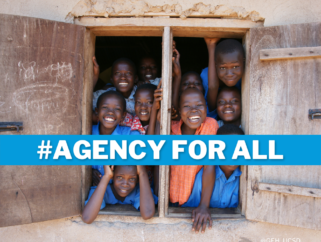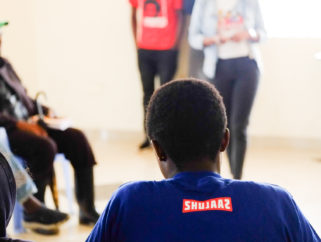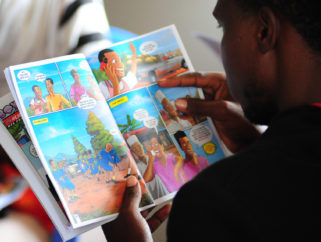The Exchange Rate Between Sex & Money; contraception meets reality in modern Kenya [ARCHIVE]
- Sex & Health
- 28 Jan 2015
“Goodness what beautiful diamonds!” gasps an admirer in Mae West’s film Diamond Lil; “Goodness” she quips back “had nothing to do with it”.
The exchange of sexual favours for money and/or gifts is well established across the world, prostitution is after all the world’s oldest profession. But are all exchanges the same and is it fair to label all women who make these exchanges sex-workers – prostitutes? Well, it depends on who is doing the labelling.
At Shujaaz we have been conducting research amongst the young women of Kenya and Tanzania with a focus on sexual behaviours and the use of contraceptives. It is ‘value judgement free’ research conducted by young people in the community where young women share their experiences and insights with us, with Shujaaz, because they see Shujaaz as being part of their world, a world where poverty, lack of education and opportunity, unfavourable gender dynamics and a health infrastructure under enormous pressure all have a huge influence on their lives. But still a world that needs to be engaged with.
And their answer to the question ‘are all girls who trade sex for money sex workers?’ is ‘No’.
When we asked young women to create groupings of themselves and their peers in their own terms three categories of sexual trading stood out – Working Girls, Material Girls and Modern Girls.
Working Girls are indeed prostitutes; these are women who are perceived to have fallen foul of the brutal realities of poverty and chance. They often have children (and this is often the reason they are sex workers – they have to pay for their child’s upkeep alone) and are perceived as ‘having no other option’ – for them the future is closed. They don’t make much money from their trade and find it impossible to get out of the poverty trap. They are sympathised with – pitied sounds patronising in this context – but avoided. Many working girls we’ve spoken with are reluctant to acknowledge what they do and when talking about themselves describe an alternative life – the life they wish they were leading. Having no positive future to look forward to they are not great users of contraceptives – any choices often overridden by clients. (We know from research conducted in Rwanda that Working Girls themselves distinguish between different types within this category, from the ‘Hotel Worker’ to the ‘Street Hustler’ for example).
Material Girls are different. They are girls who use their sexuality to make a (good) living – it is their ‘hustle’. They often have a variety of men with whom they trade different levels of sexual engagement for money, accommodation, food and gifts (not always sexual intercourse, sometimes companionship or being ‘arm candy’ is the deal). Madonna coined the phrase but these girls have been ever present in the world and in culture (The De Beers sponsored ‘Diamonds are a Girl’s Best Friend’ came from the movie adaptation of Anita Loo’s best selling ‘Gentlemen Prefer Blondes’ – perhaps the most successful product placement ever). A more recent portrayal is found in the Nigerian author Chimamanda Ngozi Adichie’s ‘Americannah’. So are these girls Working Girls or Prostitutes? Not according to the women we spoke to. But they sell sex so what differentiates them? “Self Respect” was the unanimous answer. These girls are seen as being in charge of their lives and engaging with the world on their terms. They have accepted the hard truth of a sexualised and gender imbalanced society and make the most of what they have within it (remember the ‘value judgment free’ bit earlier on? We are talking here about how our audience see and describe things). Interestingly when we talk about how these girls use contraceptives we are told that they are ‘super protected’ – they use long acting methods and condoms – they have a lucrative future to protect and they consciously manage it.
So what or who is a Modern Girl? We owe the phrase to Sanyu Mojola whose excellent book ‘Love, Money and HIV Becoming a Modern African Woman in the age of AIDS’ is based on similar research and research methodologies to ours. We too have come across school girls who are looking at the ‘modern’ consumerist world with enthusiasm and desire (Mojola is highly critical of the dynamics underpinning this drive to consumerism, something which is outside the remit of this piece). These are girls who – as Cindy Lauper might once have said ‘Just Wanna Have Fun’ – but they don’t have the financial resources to buy the latest beauty products or cool drinks. Their families are hard pressed enough keeping them at school so they turn to a ready supply of money – older men, sometimes the classic sugar daddies, sometimes boda boda motorbike taxi drivers and sometimes even teachers. The payments are often small and as Mojola points out the risks are high as these older men are not fans of contraception and have high rates of HIV and AIDS. Even if these girls did try to access contraceptive advice and resources our work shows that most clinics will show them the door and send them home mara-moja. For most of these girls the trading of sex is not a way of life but an occasional and situational reality that they anticipate will change as they grow older. They still talk of marriage and a stable adult life.
Of course none of these categories covers the daily ‘sporadic’ exchanges that many women are forced into through economic circumstances (loans running out in college), moments of weakness (a bit drunk and bored and looking for a bit of fun or distraction) or skilful coercion from cynical long and short term partners. Oscar Wilde said ‘Everything in the work place is about sex except sex. Sex is about power’ – and young women living in relative poverty have very little power.
And – just to be clear – we are not condoning the trading of sex for money especially by school girls but we do want to introduce the perspective of young women themselves into the discussion, it is too easy to either be critical of their behaviours or to be ‘shocked’ by the reality of their experience. The system is stacked against young women in East Africa and doubly so for those in poverty. Contraception is a vital tool in changing the odds. But if we are to ‘help’ without patronising or finger wagging (both counterproductive stratagems) we need to see and engage with them in their own terms.
Adam Lury





![Men Stand Up: young men’s stories of love, sex & contraception [ARCHIVE]](https://www.shujaazinc.com/wp-content/uploads/2019/12/DSCF5882-e1580146866544-321x242.jpg)